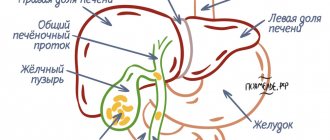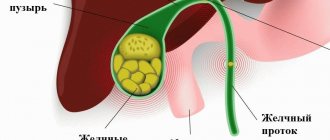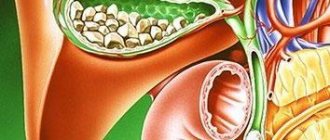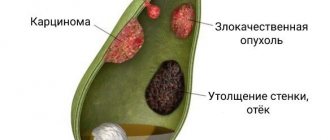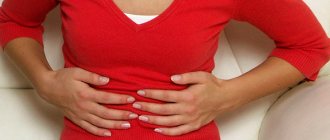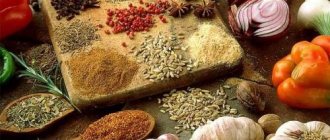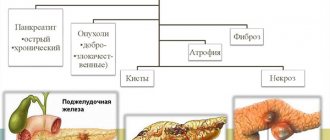- home
- Gastroenterology
- Treatment of gallstones
Treatment of gallstones is a complex and multi-stage process that requires the use of high-tech medical equipment, the best medications, and the involvement of real professionals in the field of gastroenterology. All these components are available in our clinic.
Symptoms of the disease
Sand in the gallbladder, or foreign neoplasms in the form of stones, cause painful symptoms, which will not be difficult for an experienced gastroenterologist to identify. Found gallstones? Symptoms and treatment are as follows:
- attacks of boring pain in the right hypochondrium from the liver;
- constant nausea, which stops for a short period of time, and then appears with renewed vigor with periodic urge to vomit;
- a bitter taste in the mouth due to the accumulation of bile in the stomach, and then its involuntary release into the oral cavity during belching;
- stool disorders, expressed in the form of prolonged constipation or diarrhea;
- an increase in temperature if a stone in the bile ducts has blocked the stable movement of biological fluid and caused an inflammatory process;
- jaundice of the skin, spreading from the surface of the abdomen throughout the body;
- discoloration of stool until it becomes white;
- physical weakness and general malaise;
- flatulence and increased gas formation in the intestines.
Even a small stone in the gallbladder can cause these symptoms. In case of systemic inaction, extraneous formation can provoke much more serious complications that threaten the preservation of the integrity of the digestive organ. If sand is found in the gallbladder, treatment is organized in the same way as when removing a stone formation. Only the duration of the therapeutic course is reduced.
Causes of the disease
Gallstones can reach significant sizes
Gallstones are formed from dense particles of bile. Most of them consist of cholesterol, bilirubin and calcium salts. These formations prevent the normal removal of bile from the bladder, thereby disrupting its functioning. Until stones enter the duct, a person may not know that he is suffering from gallstone disease. This disease can be caused by many factors, which include:
- heredity
- poor nutrition
- inflection of the gallbladder
- sedentary lifestyle
- pregnancy
- hormonal contraception
- elevated blood cholesterol levels
- metabolic disorders
- operations on the gastrointestinal tract
- inflammatory diseases of the gallbladder
Heredity
If one of your relatives is or has had cholelithiasis, then there is a high probability that the tendency to it can be inherited. The reason for this is that metabolic specificity can be inherited, which directly affects the occurrence of gallstones.
Poor nutrition
Lack of regularity in meals and other dietary disorders can negatively affect the functioning of the gallbladder. For example, due to fasting, a large amount of bile can accumulate in the gallbladder, and due to overeating, an increase in the size of the stomach occurs, which puts pressure on the gallbladder, thereby disrupting its functioning.
Bend of the gallbladder
In some cases, a full gallbladder may be compressed, causing so-called kinks to appear. These excesses disrupt the healthy flow of bile, which increases the risk of stones in the organ.
Sedentary lifestyle
Due to a sedentary lifestyle, bile stagnation occurs in the gallbladder. To avoid this, you need to move more and periodically engage in various physical exercises.
Pregnancy
Pain as one of the symptoms of gallstone disease
Hormonal abnormalities that accompany pregnancy can affect the functioning of the gallbladder and provoke the occurrence of gallstones.
Hormonal contraception
Some types of birth control may increase the likelihood of gallstones. Therefore, it is advisable to first consult with a gynecologist before starting to take hormonal contraceptives.
Increased blood cholesterol levels
Cholesterol is one of the components found in stones. For this reason, with an increase in its concentration in the blood, the likelihood of new stones in the gall bladder increases, or an increase in stones that already exist.
Therapy methods
Stones, sand and flakes in the gallbladder are dissolved with the help of medicines: Urosan, Henofalk and Henodeoxycholic acid. Thanks to these drugs, clinic doctors provide conservative treatment to patients without the use of surgery. By increasing the concentration of fatty acids, cholesterol levels decrease, and the outflow of bile becomes more dynamic. If this method does not bring a positive result, then the following methods are used to remove stones from the gallbladder:
- Laser destruction. The doctor, using a stream of positively charged particles, crushes foreign formations in the digestive organ and its ducts. Subsequently, the stone comes out in the form of sand along with feces.
- Surgical removal. In situations where the use of a laser is impossible due to medical contraindications, or is not advisable, a method of surgical intervention is used with opening the gallbladder and its sanitation from stones.
- Radio wave removal. The treatment method is very similar to laser disruption, but the active component is high-frequency radiation that destroys gallstones. In combination with choleretic drugs, all foreign formations are removed naturally over the next 5-7 days.
Throughout the course of treatment, we develop an individual diet for our patients to ensure maximum absorption of fatty acids and maintain stable bile circulation. In the future, this will help to avoid relapse of the disease and re-formation of stones.
Gallstone disease: symptoms, diagnosis, treatment
Did you know that being a woman (or a man) is already enough to have an increased risk of a particular disease? And we are not necessarily talking about the intimate sphere.
Today we will talk about a disease, one of the risk factors for the development of which is female gender. This is gallstone disease. With questions about her, we attended an appointment with our regular consultant, gastroenterologist at the Expert Kursk Clinic, Vasilisa Vladimirovna Ishchenko.
— Vasilisa Vladimirovna, what is gallstone disease?
This is a multifactorial, multi-stage disease of the hepatobiliary system resulting in the formation of gallstones in the gallbladder and/or bile ducts.
— Archival materials indicate that gallstones bothered even the ancient Egyptians, which is confirmed by the study of mummies. How common is cholelithiasis among modern people?
According to statistics, gallstone disease is a common disease. On a planetary scale, it occurs in approximately 10% of the population, and the number of such patients only increases with every decade.
In developed countries, the prevalence of this pathology is higher and amounts to up to 40% among adults.
In our country - from 5 to 20%. This “scatter” is associated, in particular, with the heterogeneity of disease detection. Patients do not always seek medical help.
— Is cholelithiasis reflected in ICD-10?
Yes, its classification code is K80.
— Is gallstone disease a disease of adults or do gallstones also occur in children?
Stones also occur in childhood. Until the age of 7, boys predominate; from 7 years of age until adolescence, the ratio between boys and girls is approximately the same, and then the “primacy” goes to girls (3 times more than for boys).
For what reasons can a child have a stomach ache? Deputy Chief Physician for Pediatrics says
"Clinic Expert Smolensk" Zakharov Alexey Alexandrovich
—Who is more likely to develop gallstones: men or women?
Among women.
— Why do gallstones form?
The leading factor is an increase in the lithogenicity of bile (lithogenicity is the tendency to form stones). Also, the reasons for the formation of stones include a decrease in the contractility of the gallbladder, “biliary hypertension” (increased pressure in it) and its infection.
— Can gallstones form suddenly? Or do they take time to form?
The process of stone formation is quite long, a multi-year process. However, modern diagnostics makes it possible to identify disorders even before the formation of stones, at the stage of changes in the properties of bile.
— What are the risk factors for the development of gallstone disease?
These are female gender, family history, overweight and obesity, metabolic syndrome, diabetes mellitus, liver pathologies, Crohn's disease, long-term intravenous nutrition; pregnancy; old age; some medications that disrupt the metabolism of cholesterol and bilirubin.
How to distinguish good and bad cholesterol? Cardiologist, Candidate of Medical Sciences says:
Ovsyannikov Alexander Georgievich
— What role does genetic predisposition play in the occurrence of this disease?
This is one of the leading factors. There is a connection between certain regions of the genome and an increased risk of developing this pathology. If one of them is inherited, the risk increases to 30%, and if two of them are inherited, the risk increases to 70%. Often, hereditary burden can be established already during a survey, when, in particular, it turns out that the patient’s mother also had or has cholelithiasis.
— What signs do patients have when they have gallstones?
Most often, no manifestations are noted. This kind of latent stone carriage is a stage of this disease.
A dyspeptic form is also isolated (it is rarely found in isolation). It is characterized by a disorder of the digestive system with periodic pain, a feeling of heaviness in the epigastric region, bloating, unstable stools, heartburn, a feeling of bitterness in the mouth, i.e. nonspecific symptoms.
The most striking picture is of biliary colic - another type of this pathology (currently the term has been changed and is called “biliary pain”). There is a pronounced pain syndrome with characteristic irradiation to the right shoulder, the interscapular space and the area of the right scapula, neck, and lower jaw. A connection between biliary pain and errors in diet has been noted. During an attack, laboratory tests may change (the erythrocyte sedimentation rate increases, the number of leukocytes increases).
The painful torpid form is characterized by a long, persistent, constant pain syndrome that does not have typical manifestations in laboratory tests. However, you can suspect it already at the stage of examination by a doctor.
— Can gallstone disease be asymptomatic or put on “masks” of other diseases?
Yes, it may not manifest itself for a long time, leading in some cases to the development of serious complications.
Also, cholelithiasis can “masquerade” as many diseases of the organs of the upper half of the abdominal cavity. These are pancreatitis, hepatitis, cholecystitis, gastritis and duodenitis, etc.
How should and how NOT should gastritis be treated? Read here
— Vasilisa Vladimirovna, how is gallstone disease diagnosed?
If there are complaints, suspicion of its presence may arise already at the stage of examination by a doctor. However, the leading method for making this diagnosis is ultrasound, and gallstone disease is often an accidental finding - for example, during a preventive study. According to indications, retrograde cholangiopancreatography and percutaneous transhepatic cholangiography are used - for example, when ultrasound does not reveal stones in the bile ducts.
How to prepare for an abdominal ultrasound? Find out here
To clarify the question of the nature and density of the stone, a CT scan of the abdominal cavity can be used.
— How is a patient treated when gallstones are detected?
It is important to adhere to a diet: fatty, spicy, salty, smoked, sweet, and sour foods are excluded. Ursodeoxycholic acid preparations are used to dissolve some stones (not all types are soluble, and for some stones these medications are contraindicated). To prescribe such treatment, stones must have very specific characteristics, and the bile ducts must be passable, etc.
Choleretic drugs and herbs are contraindicated.
Is it possible to cleanse the liver? Read here
— Are stones in the gall bladder always an indication for surgery?
It depends on at what stage the diagnosis is made, what type of stones are and how they “respond” to drug treatment. If they are small and gradually decrease when therapy is prescribed, then the patient is treated and observed by the doctor’s decision and after mandatory consultation with a surgeon. If there is no effect from the drugs or the presence of symptoms, the question of surgery is raised. In case of complications - removal of the gallbladder for health reasons.
— How do gallstones threaten a person’s health and life? What happens if gallstone disease is not treated?
It is dangerous due to its complications. Among them are cholecystitis; blockage of the gallbladder duct; obstructive jaundice; formation of fistulas (including between the gallbladder and intestine); dropsy or suppuration of the gallbladder; pancreatitis; intestinal obstruction caused by gallstones, etc.
There are also studies showing that patients with gallstones have an increased risk of developing gallbladder cancer.
— What needs to be done to keep the gallbladder healthy?
Primary prevention consists of developing a healthy lifestyle, following the principles of a balanced diet (it is necessary to exclude smoked foods, refractory fats, irritating seasonings, and sweets. The diet should include a large amount of plant fiber, which normalizes intestinal motility and reduces the lithogenicity of bile).
Once a year, it is necessary to perform an ultrasound of the liver and gallbladder and, if there are changes, immediately consult a doctor.
You can sign up for an ultrasound scan of the liver and gallbladder here
Please note: diagnostics are not available in all cities
For reference
Ishchenko Vasilisa Vladimirovna
In 2015, she graduated from Kursk State Medical University with a degree in General Medicine.
In 2016, she completed an internship in the specialty “Therapy” and in the same year – professional retraining in gastroenterology.
Since 2022, he has been holding the position of gastroenterologist at Klinka Expert Kursk LLC.
Herbal infusions
Collections from various medicinal herbs have always helped maintain good health. Their healing properties help remove stones from the gallbladder. There are many known combinations and cooking methods.
First option
Includes:
- Knotweed (3 hours).
- Pharmaceutical chamomile (1 tsp).
- Sandy immortelle (4 hours).
- St. John's wort (4 hours).
- Buckthorn bark (2 hours).
An infusion is made from the above herbs, to which the mixture (4 spoons) is added. Place the mixture in cold water (1 liter), leaving to infuse until the morning. Then cook, when the liquid reaches boiling point, wait ten minutes and remove from heat. The cooled drink must be filtered.
Drinking the infusion is indicated in the correct way: a glass in the morning, consume no more than five glasses per day, the decoction is taken after meals. This option is ideal in the fight against cholesterol stones.
Second option
Ingredients Includes:
- Kidney tea (10 g).
- Stinging nettle (10 g).
- Horsetail (10 g).
- Knotweed herb (20 g).
A set of herbs is poured with half a liter of hot water and left for six hours to allow the ingredients to brew. If a person is diagnosed with a disease associated with a disruption in the functioning of the bile ducts, the collection is taken three times a day, but you cannot drink more than half a glass at a time. Be sure to warm the drink before ingestion.
Third option
List of plants required:
- Madder roots (4 hours).
- Immortelle flowers (1 hour).
- Mint petals (1 tsp).
- Buckthorn bark (1 tsp).
- Wormwood (1 tsp).
- Dandelion roots (1 tsp).
Pour the mixture (10 g) and boiling water (250 ml) over the mixture and put on fire for 15 minutes. Then cool to room temperature. Drink half a glass a day. Special condition: per day you are allowed to take the drink no more than twice before meals.
Fourth option
You need to assemble the following components:
- Corn silk (1 tsp).
- Green beans (1 tsp).
- Herb "bear ears" (1 tsp).
- Smooth hernia (1 hour).
- Knotweed (1 hour).
Add the mixture (15 g) to the mixture, pour hot water over the mixture. To brew well, wrap it in a warm blanket. After several hours of waiting, the herbs are strained. The collection is accepted exclusively warm.
Fifth option
Plants you will need:
- Immortelle flowers (3 hours).
- Yarrow herb (5 hours).
- Rhubarb roots (2 tsp).
The collection is filled with 250 ml of hot water and a mixture (5 g) is added to it. Place the saturated solution in a cool place so that the temperature does not exceed room temperature. Then squeeze to make the drink thick and rich. Take once a day, a glass before the last meal.
Spiny healer
Milk thistle is a type of herbaceous plant that has medicinal properties. The seeds of the plant consist of useful components: antioxidants, vitamins, minerals and enzymes. In addition to disturbances in the functioning of the bile reservoir and ducts, milk thistle is used to heal the liver. Treatment of gallstone disease with folk remedies often includes milk thistle in recipes.
Beneficial features
The plant improves the functioning of bile secretion and digestion, stabilizes metabolism, significantly reduces the amount of sugar in the blood, and has a positive effect on blood vessels. The plant contains: manganese, potassium, calcium, iodine, boron, groups of vitamins, minerals.
Milk thistle seeds are included in expensive medications and health measures for disorders of the biliary tract. You can prepare the medicine yourself by checking with your doctor about the possibility of using the course.
Application
Milk thistle seed powder, from which useful decoctions are prepared, is called meal. Buy at any store or pharmacy. Other recipes with the plant are also known. For example, the herb is consumed in the form of various alcohol tinctures, oil is made, and added to dishes.
A decoction of the seeds treats damage to the bile duct or liver. To prepare, you will need 30 g of plant seeds, crushed to a powder. The mixture is filled with half a liter of hot water. Boil exactly until the contents are reduced by half. Then the broth is filtered. This medicine is taken quite often: a spoonful per hour. The treatment cycle lasts two months.
